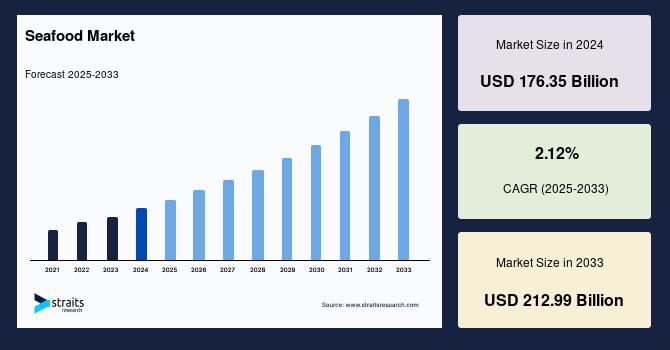Global Seafood Market Outlook: Trends, Growth Factors, and Regional Insights

The global seafood market size was valued at USD 176.35 billion in 2024 and is estimated to reach from USD 180.08 billion in 2025 to USD 212.99 billion by 2033, growing at a CAGR of 2.12% during the forecast period (2025–2033).
Rising Demand Driven by Health and Nutrition Awareness
Seafood is widely recognized as a healthy source of essential nutrients, including high-quality proteins, vitamins, minerals, and omega-3 fatty acids. These nutritional benefits, especially omega-3 fatty acids promoting cardiovascular health, have played a significant role in driving consumer demand globally. Increasing urbanization and disposable income levels have enabled more people to include seafood regularly in their diets. The growing inclination towards pescetarianism a diet including seafood but excluding other meats also supports the market expansion, propelled by health-conscious consumers searching for alternatives to red meat and poultry.
Economic Growth and Changing Consumption Patterns
Economic recovery in various developing economies has resulted in enhanced disposable incomes among the middle-income population groups, particularly in Asia-Pacific and North America. Urban consumers are increasingly shifting from essential to premium food products, including a variety of seafood offerings. The expansion of fast-food restaurants and seafood-serving establishments also contributes to the increasing availability and consumption of seafood, supporting market growth.
Environmental and Sustainability Challenges
While demand grows, the seafood market faces challenges related to sustainability and environmental impact. Over 90% of fish stocks have been reported as overexploited, with some species facing endangerment due to unsustainable fishing and pollution. Aquaculture is being emphasized as a sustainable alternative to meet global seafood demand, supported by new regulations to control excessive fishing. Industry players, from fishermen to food service providers, are increasingly adopting environmentally sustainable and socially responsible practices to balance growth with conservation.
Market Segmentation and Trends
-
Fish segment: The dominant segment within the global seafood market, expected to grow at a CAGR of around 2.2%. Popular fish species include salmon, catfish, and tilapia, available from both wild catch and aquaculture.
-
Mollusks: This segment includes oysters, scallops, clams, and mussels, with increasing demand driven by their nutritional value and the luxury market for pearls.
-
Retail sector: Retail remains the leading distribution channel, expanding through improved infrastructure and the rise of online and offline sales channels. Large retail stores offering convenience, discounts, and one-stop shopping enhance consumer access to seafood products.
-
Institutional segment: Growing office and research institutions broadly provide seafood as a primary protein source, further driving steady demand in this segment.
Regional Market Insights
-
Asia-Pacific: Holds the largest share of the global seafood market and is poised to maintain robust growth at a CAGR of 2.2%. Factors include rising incomes, urbanization, increasing dining out, and a booming aquaculture industry led by countries such as China, Japan, and Vietnam. China notably invests heavily in fish and shrimp farming operations.
-
North America: A mature market with a well-developed supply chain and high consumer awareness. The increasing popularity of seafood among health-conscious consumers fuels demand, supported by strong harvesting from wild fisheries, especially in states like Alaska and California.
-
Europe: Expected to exhibit steady growth driven by high per capita consumption in countries such as Spain and Italy. The regional market benefits from the growing preference for fish and seafood and increasing awareness of related health benefits.
Industry Outlook
The seafood market's future growth relies on balancing rising consumer demand with sustainability concerns. While the loss of sea species and environmental degradation hinder growth, progress in sustainable fishing practices and aquaculture innovation offers hope. Seafood providers and restaurants increasingly focus on sustainable offerings, catering to environmentally aware consumers.
Economic improvement, evolving eating habits, and better supply chain infrastructures will continue to shape the seafood industry's landscape globally. Overall, the market is expected to expand steadily, driven by the convergence of nutrition awareness, environmental responsibility, and technological advances in seafood production and distribution.
- Новости
- Происшествия
- История
- Искусство
- Рукоделие
- Танцы
- Еда / Напитки
- Кино / Фильмы
- Фитнес
- Игры
- Садоводство
- Здоровье
- Дом
- Литература
- Музыка
- Соцсети
- Другое
- Религии
- Спорт
- Театр
- Природа
- Товары
- Наука и техника
- Мода


